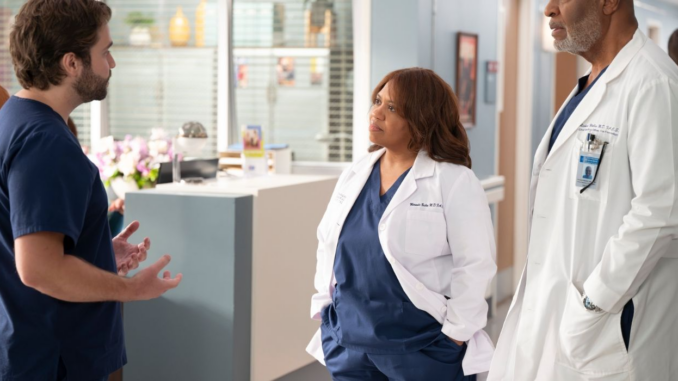
Introduction: The Dilemma of Character Replacements in Grey’s Anatomy
When we think of Grey’s Anatomy, many of us recall iconic moments, unforgettable characters, and dramatic plot twists that had us glued to the screen. However, one of the show’s recurring challenges has been its constant rotation of characters. While the show has managed to survive for over 18 seasons, there’s an undeniable issue that threatens its very heart – the replacement of beloved characters.
You might be wondering, “How could a few new faces be so detrimental?” The answer is layered, and it delves into how these changes impact character development, audience engagement, and ultimately, the heart of Grey’s Anatomy.
In this article, we’ll explore the consequences of replacing key characters, how these shifts affect the audience’s emotional connection, and whether this constant turnover is leading to the downfall of one of TV’s most beloved medical dramas.
The Challenge of Maintaining Consistency in a Long-Running Show
As Grey’s Anatomy continues to evolve, it becomes more apparent that keeping things fresh while maintaining consistency is a tricky balancing act. Many of the original cast members have moved on to pursue other projects, leaving the series with a revolving door of new characters. The show’s ability to adapt has allowed it to stay relevant, but at what cost?
The Emotional Toll of Losing Original Characters
When we think about Grey’s Anatomy, we think of Meredith Grey, Derek Shepherd, Cristina Yang, and the other originals who have shaped the story over the years. With their departures, the show has lost not just characters, but an emotional connection that viewers had cultivated over many seasons.
Each new replacement doesn’t simply fill the void left by the original. Instead, it creates an emotional disconnect that disrupts the narrative flow. Fans are left trying to bond with new faces who may never quite live up to the iconic roles they’ve replaced. This cycle of replacements has often made the show feel less like a cohesive family and more like a revolving door of fleeting relationships.
Why Character Replacements Don’t Always Work
While replacing characters may seem like a natural way to introduce fresh dynamics and keep the show moving, it often fails to retain the deep connections fans have to the original cast. Here’s why:
Character Development Takes Time
Great television characters don’t emerge overnight. They are products of years of development, personal struggles, victories, and relationships. The more we get to know a character, the more invested we become in their journey. Replacing characters too frequently forces the audience to start from scratch with each new face, losing the intricate bond they once had with the previous characters.
Unfinished Storylines Leave Fans Frustrated
Another consequence of replacing characters is the untapped potential of their story arcs. When a major character leaves the show, it often results in the abrupt end of plot lines that may have been building for seasons. The decision to replace these characters can feel like an incomplete narrative that leaves fans unsatisfied.
How Replacements Impact Fan Loyalty
Can Fans Really Bond with New Faces?
If we are being honest, the emotional pull of Grey’s Anatomy has always been its characters. The audience has followed these individuals through their professional highs, personal lows, love lives, and heartbreaks. It’s hard to replicate that level of connection with new characters who haven’t yet been tested in the same ways.
The Struggle to Relate to New Characters
Take, for example, the replacements of Dr. Christina Yang and Dr. Alex Karev. While their successors, such as Dr. Maggie Pierce and Dr. Jo Wilson, are strong characters in their own right, they don’t quite have the same spark that made fans fall in love with the originals. As a result, viewers may feel as though they are constantly adjusting to new personalities and storylines that aren’t as compelling.
The Disruption of Fan-Favorite Dynamics
The best shows have undeniable chemistry between their lead characters. When Meredith Grey and Cristina Yang left, so did the signature dynamic that defined much of the show’s success. The same can be said about many other characters who were replaced or written off. Each time one of these characters exits, the emotional core of the show is fractured.

The Risks of Constant Change in Long-Running Shows
In the world of television, Grey’s Anatomy has remained an anomaly. It’s rare for a show to stay on air for so long while constantly reinventing itself with new cast members. However, this longevity comes at a price.
The “Newness” of Characters Can’t Compete with Legacy
While the introduction of new characters is an effort to inject energy and novelty into the show, it often falls short. New characters cannot immediately compete with the legacy of those who’ve been around for years. Viewers develop a deep attachment to the characters they’ve seen grow and evolve over seasons. Replacing these characters means sacrificing that emotional payoff.
Why It’s Hard to Replace Great Characters
If Grey’s Anatomy has taught us anything, it’s that some characters are irreplaceable. The relationships between these characters are not just part of the plot, but integral to the show’s identity. The beauty of Grey’s Anatomy lies in its rich, complex characters – and when they’re replaced too quickly, the essence of the show begins to erode.
Meredith Grey: The Heartbeat of the Show
Meredith Grey has always been at the center of Grey’s Anatomy. Her personal growth and relationships have shaped the trajectory of the entire series. The constant introduction of new characters, while attempting to shift focus, has often felt like an attempt to fill a void that can never truly be filled.
Cristina Yang: The Dynamic Presence Lost
Cristina Yang, played by Sandra Oh, is another irreplaceable character. Her departure left a noticeable void, and while the show tried to fill it with characters like Dr. Maggie Pierce, none could replicate the fiery chemistry Cristina had with Meredith or the boldness she brought to the show.
Could This Trend Signal the End of Grey’s Anatomy as We Know It?
The Potential Downfall of Character Replacements
As Grey’s Anatomy continues to replace characters, it risks losing its signature charm. Viewers who once tuned in to watch their favorite characters evolve are now left grappling with the constant shuffle of new faces. If the show cannot recapture the magic of its early seasons, we may be looking at a slow decline.
What Does the Future Hold for Grey’s Anatomy?
Will Grey’s Anatomy be able to bounce back from its character replacement crisis, or will it be doomed to lose its loyal following? Only time will tell. However, one thing is clear: without solid, consistent character development, the show risks losing its ability to truly resonate with its audience.
Conclusion: Is the Constant Rotation of Characters Hurting the Show?
In conclusion, while the introduction of new characters on Grey’s Anatomy was meant to keep the show fresh, it may ultimately be causing more harm than good. The emotional connection that fans have with iconic characters can never be easily replaced. The constant turnover leaves little room for the kind of deep character arcs that made the show great.
At its core, Grey’s Anatomy is a story about relationships – both personal and professional. As long as the show continues to introduce new characters while leaving behind old favorites, it risks diluting the very essence that made it a cultural phenomenon.
FAQs
1. Why do characters leave Grey’s Anatomy so often?
Many characters leave for various reasons including actors pursuing other projects, creative decisions by the show’s writers, or the natural progression of storylines. This turnover, however, has created a problem in maintaining continuity and emotional connection with the audience.
2. Can Grey’s Anatomy recover from its character replacement issues?
It’s possible, but it would require a stronger focus on character development and perhaps bringing back familiar faces to restore the show’s emotional core.
3. What happened to the original characters on Grey’s Anatomy?
Over time, most of the original characters left the show for different reasons, including personal growth for the actors and natural narrative arcs that required their departure.
4. How do character replacements affect the audience’s engagement with the show?
Character replacements often create a sense of instability, making it hard for the audience to form deep emotional connections with new characters. This can lead to disengagement and frustration.
5. Will Grey’s Anatomy ever be the same after all the replacements?
The show will likely continue to evolve, but it’s clear that the magic of the original cast will be hard to recapture. Fans may need to adjust their expectations as new dynamics unfold.
